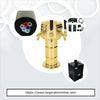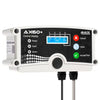Selecting the right trunk line, part 2: Calculation examples for long draw system balancing
In the first part of this blog post we covered what should be considered when buying a trunk line for any long draw installation.
In this blog post we cover some examples of possible long-draw beer systems and how to calculate the right beer line sizes. We are going to make some assumptions with the numbers, just to make the examples easy to understand.
The calculations really work for a single product line at a time, as the keg pressure is one of the main considerations. In real life situations, the keg pressures should be adjusted individually, or they could be divided to different pressure groups. The tower (choker) lines should be adjusted accordingly. The net vertical lift / drop is assumed as 3 feet in all examples, again for simplicity. Of course in real life this number varies.
The carbonation / keg pressure and line restriction numbers come from these tables:
Beer carbonation levels (volumes of beer) at specific temperature & required pressure levels in psi
| Vol. CO2 | 2.1 | 2.2 | 2.3 | 2.4 | 2.5 | 2.6 | 2.7 | 2.8 | 2.9 | 3.0 | 3.1 |
| Temp. F | psi | psi | psi | psi | psi | psi | psi | psi | psi | psi | psi |
| 33 | 5.0 | 6.0 | 6.9 | 7.9 | 8.8 | 9.8 | 10.7 | 11.7 | 12.6 | 13.6 | 14.5 |
| 34 | 5.2 | 6.2 | 7.2 | 8.1 | 9.1 | 10.1 | 11.1 | 12.0 | 13.0 | 14.0 | 15.0 |
| 35 | 5.6 | 6.6 | 7.6 | 8.6 | 9.7 | 10.7 | 11.7 | 12.7 | 13.7 | 14.8 | 15.8 |
| 36 | 6.1 | 7.1 | 8.2 | 9.2 | 10.2 | 11.3 | 12.3 | 13.4 | 14.4 | 15.5 | 16.5 |
| 37 | 6.6 | 7.6 | 8.7 | 9.8 | 10.8 | 11.9 | 12.9 | 14.0 | 15.1 | 16.1 | 17.2 |
| 38 | 7.0 | 8.1 | 9.2 | 10.3 | 11.3 | 12.4 | 13.5 | 14.5 | 15.6 | 16.7 | 17.8 |
| 39 | 7.6 | 8.7 | 9.8 | 10.8 | 11.9 | 13.0 | 14.1 | 15.2 | 16.3 | 17.4 | 18.5 |
| 40 | 8.0 | 9.1 | 10.2 | 11.3 | 12.4 | 13.5 | 14.6 | 15.7 | 16.8 | 17.9 | 19.0 |
| 41 | 8.3 | 9.4 | 10.6 | 11.7 | 12.8 | 13.9 | 15.1 | 16.2 | 17.3 | 18.4 | 19.5 |
| 42 | 8.8 | 9.9 | 11.0 | 12.2 | 13.3 | 14.4 | 15.6 | 16.7 | 17.8 | 19.0 | 20.1 |
Beer tubing restrictions & amount of beer per foot by line type (note: trunk lines are barrier, stainless is used in some towers)
|
Type |
Size |
Restriction |
Volume |
|
Vinyl |
3/16” ID |
3.00 lbs/ft |
1/6 oz/ft |
|
Vinyl |
1/4” ID |
0.85 lbs/ft |
1/3 oz/ft |
|
Vinyl |
5/16” ID |
0.40 lbs/ft |
1/2 oz/ft |
|
Vinyl |
3/8” ID |
0.20 lbs/ft |
3/4 oz/ft |
|
Vinyl |
1/2” ID |
0.025 lbs/ft |
1 1/3 oz/ft |
|
Barrier |
1/4” ID |
0.30 lbs/ft |
1/3 oz/ft |
|
Barrier |
5/16” ID |
0.10 lbs/ft |
1/2 oz/ft |
|
Barrier |
3/8” ID |
0.06 lbs/ft |
3/4 oz/ft |
|
Stainless |
1/4” OD |
1.20 lbs/ft |
1/6 oz/ft |
|
Stainless |
5/16” OD |
0.30 lbs/ft |
1/3 oz/ft |
|
Stainless |
3/8” OD |
0.12 lbs/ft |
1/2 oz/ft |
Example 1: Straight CO2 system with a 20 feet of trunk line
Beer temperature: 34F
Carbonation: 2.5 volumes of CO2 per volume of beer
Gas pressure needed to maintain carbonation (keg pressure): 9.1 psi
Static resistance:
3 feet of vertical lift (from the middle of the keg to the faucet) - 3 x 0.5 pounds = 1.5 lbs of static resistance
Dynamic resistance:
We have 9.1 psi of pressure, that needs to have the same amount of resistance to achieve the proper flow rate. As the static resistance gives us 1.5 lbs, we still need 9.1 - 1.5 = 7.7 lbs of resistance. Let's assume the tower has a 5 feet line of 3/16" I.D product line, giving 15 pounds of resistance. That's already more than we need, so the tower line must actually be shortened... but by how much? As we are already over the resistance target, let's just select the trunk line with least resistance: 3/8" I.D. It has 0.06 lbs of resistance per foot, so 0.06 * 20 = 1.2 pounds of total trunk line resistance for the 20 feet run.
As we now know that our static resistance is 1.5 pounds (can't make that lower), and trunk line resistance is 1.2 pounds (can't get that lower either), that gives as a starting resistance of 2.7 pounds. To get to the target of 9.1 pounds, we need the tower line to have 6.4 pounds of resistance. As we know it has 3 pounds of resistance per foot, we need to shorten it to 6.4 / 3 = 2.13 feet.
This calculation doesn't yet take into account the possible jumper lines in the cooler room. If 6 feet of 3/8" I.D vinyl line is used there, that will increase the resistance by further 6 * 0.2 pounds = 1.2 pounds. If we take this into account, the choker/tower line should be even shorter. It should give us a resistance of 9.1 - 2.7 - 1.2 = 5.2 lbs, meaning 5.2 / 3 = 1.73 feet in length.
As some of the tower line is running inside the tower, cutting it much shorter might not even be practical. If even shorter lines would be needed, the best solution would be to change the tower line to 1/4" I.D vinyl line (with only 0.85 lbs/ft restriction).
Example 2: 100 feet run with mixed 60/40 gas
Gas mix: 60% CO2 / 40% nitrogen
Beer temperature: 34F
Carbonation: 2.5 volumes of CO2 per volume of beer
Gas pressure needed to maintain carbonation (partial CO2 keg pressure): 9.1 psi
Total gas mix pressure (will be explained in a later blog post): 24.82 psi
Static resistance:
3 feet of vertical lift (from the middle of the keg to the faucet) - 3 x 0.5 pounds = 1.5 lbs of static resistance
Dynamic resistance:
Tower resistance with 5 feet lines: 15 pounds
Resistance from jumper lines: 1.2 pounds
Minimum resistance needed from the trunk line (without increasing choker line lengths): 24.82 - 15 - 1.2 = 7.12 pounds
Let's look at different trunk line resistance numbers at a 100 feet run.
100 feet of 1/4" I.D trunk line: 100 x 0.3 pounds = 30 pounds
100 feet of 5/16" I.D trunk line: 100 x 0.1 pounds = 10 pounds
100 feet of 3/8" I.D trunk line: 100 x 0.06 pounds = 6 pounds
As we can see, the 1/4" would give us too much resistance. 3/8" would need us to increase the choker lines longer than 5 feet. The best solution would be to choose the 5/16" I.D line and adjust the choker line like follows:
Resistance from trunk line 10 lbs, jumper lines 1.2 lbs, static 1.5 lbs, leaving 24.82 - 10 - 1.2 - 1.5 = 12.12 lbs for the choker line. As the 3/16" vinyl restriction is 3 lbs/ft, the choker length would need to be 12.12 / 3 = 4.04 feet.
Example 3: 50 feet run with larger diameter choker line
Beer temperature: 34F
Carbonation: 2.5 volumes of CO2 per volume of beer
Gas pressure needed to maintain carbonation (keg pressure): 9.1 psi
Static resistance:
3 feet of vertical lift (from the middle of the keg to the faucet) - 3 x 0.5 pounds = 1.5 lbs of static resistance
Dynamic resistance:
Tower resistance with 5 feet 1/4" I.D vinyl lines: 5 * 0.85 = 4.25 pounds
Resistance from jumper lines: 1.2 pounds
Total resistance without trunk line = 1.5 + 4.25 + 1.2 = 6.95 pounds. Trunk line resistance choices for 50 feet:
1/4" I.D trunk line: 50 x 0.3 pounds = 15 pounds5/16" I.D trunk line: 50 x 0.1 pounds = 5 pounds
3/8" I.D trunk line: 50 x 0.06 pounds = 3 pounds
The 1/4" I.D would again give us too much resistance, as would 5/16". With 3/8" we get to 6.95 + 3 = 9.95, close to our target of 9.1. We can again account for the difference by cutting the choker line (with 0.85 lbs/ft resistance) to only give 3.4 pounds of resistance, 3.4 / 0.85 = 4 feet.
Example 4: 75 feet run, 1/4 choker line, 38F beer with more carbonation
Beer temperature: 38F
Carbonation: 2.8 volumes of CO2 per volume of beer
Gas pressure needed to maintain carbonation (keg pressure): 14.5 psi
Static resistance:
3 feet of vertical lift (from the middle of the keg to the faucet) - 3 x 0.5 pounds = 1.5 lbs of static resistance
Dynamic resistance:
Tower resistance with 5 feet 1/4" I.D vinyl lines: 5 * 0.85 = 4.25 pounds
Resistance from jumper lines: 1.2 pounds
Total resistance without trunk line = 1.5 + 4.25 + 1.2 = 6.95 pounds. Trunk line resistance choices for 75 feet:
1/4" I.D trunk line: 75 x 0.3 pounds = 22.5 pounds
5/16" I.D trunk line: 75 x 0.1 pounds = 7.5 pounds
3/8" I.D trunk line: 75 x 0.06 pounds = 4.5 pounds
The 1/4" I.D would again give us too much resistance, and 3/8" too little. With 5/16" we get to 6.95 + 7.5 = 14.45, close enough to counter our target pressure of 14.5 psi.
Conclusion
We hope this blog post was helpful, and if you're ready to order, you can browse our trunk line selection here! If you need help with your own installation, please contact us!










